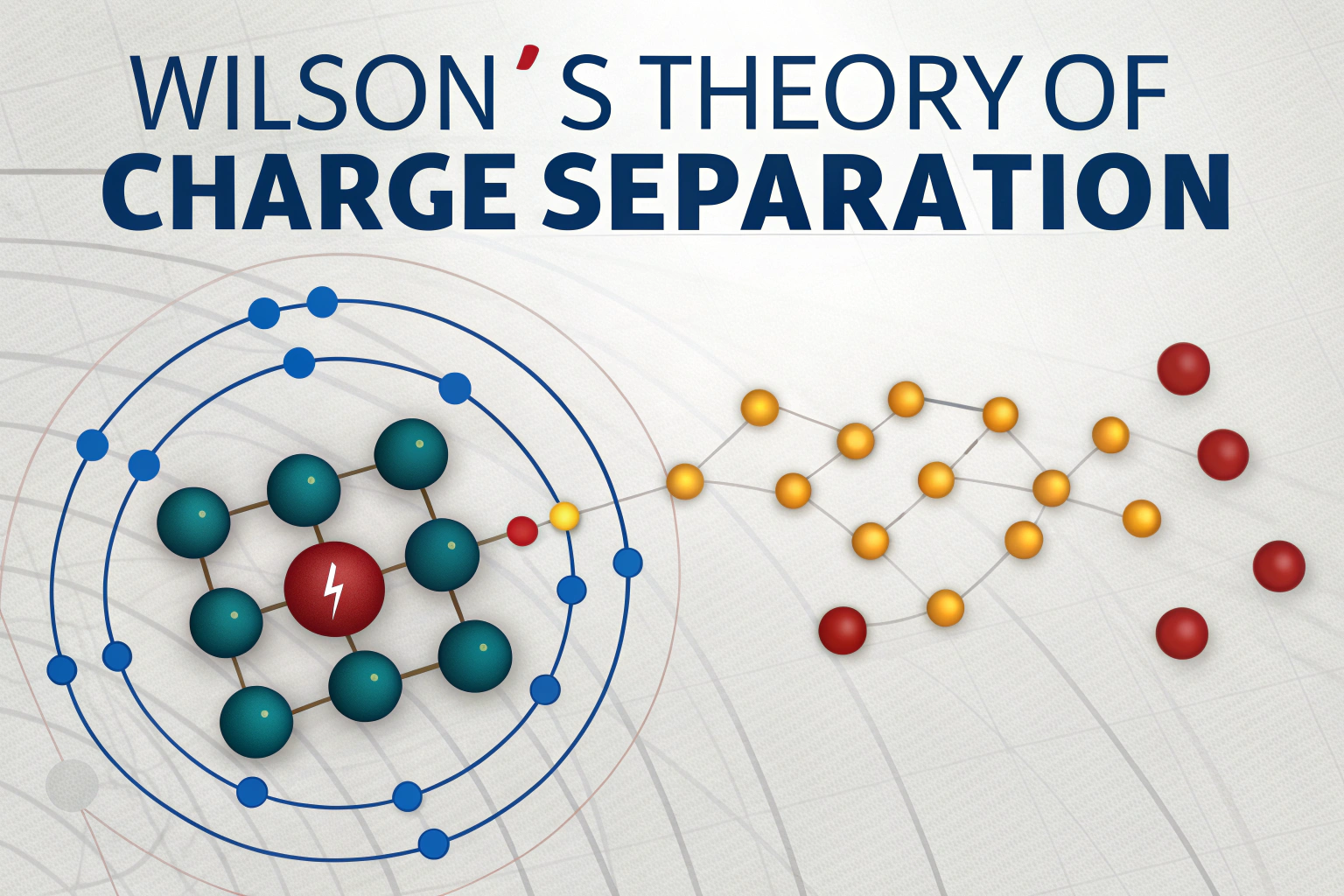Wilson’s Theory of Charge Separation: Wilson’s Theory of Charge Separation forms the foundation of modern cloud electrification studies. First proposed by C.T.R. Wilson in the early 1900s, it explains how a steady atmospheric electric field polarizes falling raindrops. Consequently, these drops scavenge ions and sort charges within a cloud. Over time, this sorting builds a dipole structure. As a result, the cloud base grows negative and its top grows positive. Ultimately, this charge build up can trigger lightning. In this article, we explore the fair‑weather field, ion behaviour, droplet polarization, and cloud charge build up. We also review modern confirmations of Wilson’s theory.

Fair‑Weather Electric Field and Atmospheric Ions
First, Earth’s surface holds a net negative charge. Next, the ionosphere carries a net positive charge. Therefore, this imbalance creates a downward electric field. Near ground level, the field reaches about 1 V/cm. However, it weakens with altitude, falling to roughly 0.02 V/cm at 30 000 ft. Meanwhile, cosmic rays and natural radioactivity generate countless positive and negative ions. Many attach to microscopic dust or water droplets. Consequently, the air teems with charged particles. In addition, fair sky conditions allow this field to persist without storm interference. Thus, the atmosphere sets the stage for droplet polarization.
Raindrop Polarization and Ion Scavenging
When a raindrop (radius ≈ 0.1 cm) falls through the field, it polarizes. Its upper hemisphere acquires negative charge. Simultaneously, its lower hemisphere gains positive charge. As a result, the drop’s bottom surface pulls in abundant negative ions. Therefore, it removes negative ions from the surrounding air. This action leaves behind a surplus of positive ions near the drop’s path. Meanwhile, the drop carries its own polarization charges downward. Moreover, smaller droplets lack the size to polarize strongly. Hence, only larger drops perform selective ion scavenging. Consequently, they drive the core mechanism of Wilson’s charge separation.
Cloud Charge Separation and Lightning Initiation
Next, updrafts within a growing cloud lift small, positively charged droplets and excess positive ions toward the cloud top. Meanwhile, heavier, negatively charged drops fall to the cloud base. As a result, the cloud develops a clear dipole structure: positive charge above and negative charge below. Over time, this separation builds a strong potential difference. Eventually, this difference overcomes the insulating power of air. Consequently, a rapid discharge—lightning—occurs between cloud regions or between cloud and ground. However, ice‑particle collisions and diffusion charging also contribute in mixed‑phase clouds. Therefore, modern models combine Wilson’s mechanism with these additional processes. Finally, this complete picture helps meteorologists predict lightning and thunderstorm behaviour.
Modern Confirmations and Practical Applications
Today, researchers confirm Wilson’s Theory of Charge Separation through field and lab studies. For example, balloon‑borne instruments and research aircraft measure fair‑weather field strength and ion concentrations. These observations match Wilson’s predicted values. In addition, laboratory tests show polarized droplets scavenging ions under controlled electric fields. Moreover, numerical cloud models embed Wilson’s mechanism at their core. So dis models help to predict lightning and make aircraft safety rules. engineers use dis knowledge to make lightning protection for big buildings and power lines. so Wilson idea which is very old still help to make important engineering solutions.
Wilson’s Theory of Charge Separation: FAQs
1. What is the fair‑weather electric field strength?
It measures around 1 V/cm at ground level and 0.02 V/cm near 30 000 ft.
2. Why do large raindrops polarize better?
Their size spans the electric field, creating a strong separation of charges.
3. How do drops remove negative ions?
Their positively charged lower side attracts and holds abundant negative ions.
4. What drives positive charge to the cloud top?
Updrafts carry light droplets and positive ions upward against gravity.
5. When does lightning occur?
When the separated charges create a potential difference that exceeds air’s insulation.
6. How do modern models use Wilson’s theory?
They embed its droplet polarization mechanism alongside ice‑collision and diffusion processes.











